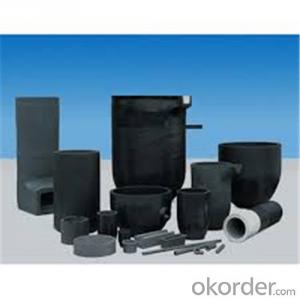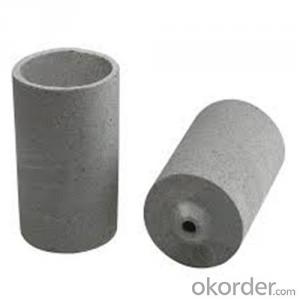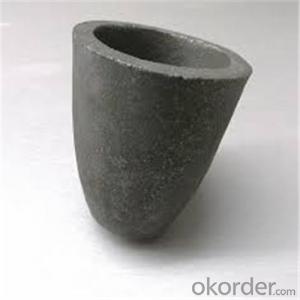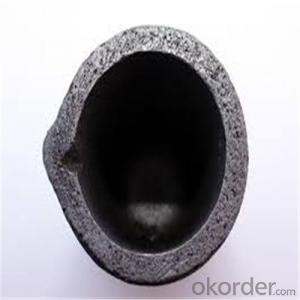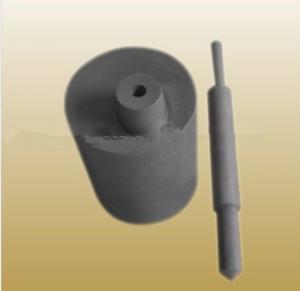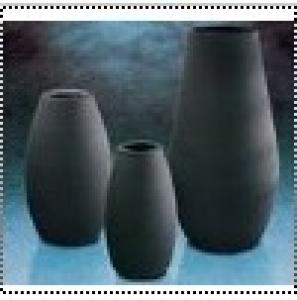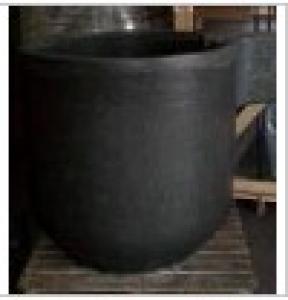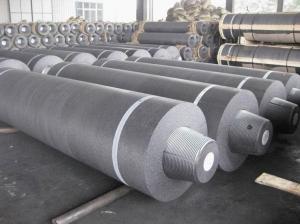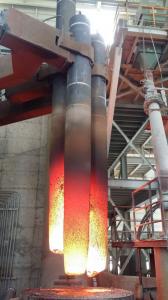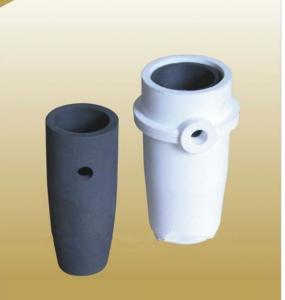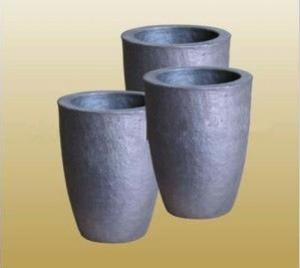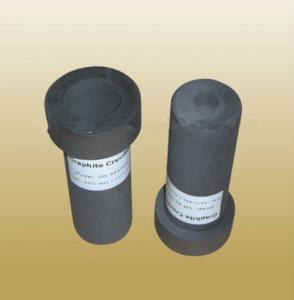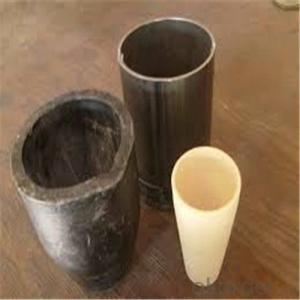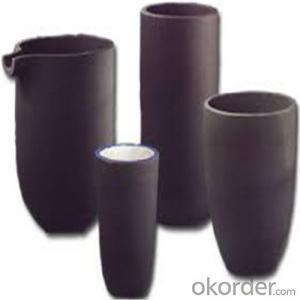Refractory Crucibles Sic Crucible For Brass/Aluminum
- Loading Port:
- Shanghai
- Payment Terms:
- TT OR LC
- Min Order Qty:
- 1 pc
- Supply Capability:
- 1000 pc/month
OKorder Service Pledge
OKorder Financial Service
You Might Also Like
Quick Details for Refractory Crucibles Sic Crucible For Melting Copper/Brass/Aluminum
| Type: | High Strength, graphite crucible crucible | Application: | melting metal | Height: | as your requirements |
| Composition: | High Pure | Top Diameter: | 10-600mm | Bottom Diameter: | 10-1000mm |
| Place of Origin: | China (Mainland) | Brand Name: | Model Number: | ||
| Color: | Black grey | Si3N4%: | 5min | Fe2O3%: | 0.7max |
| C%: | 30-45 | Apparent porosity: | 30max | Refractoriness: | 1680 |
| Bulk Density: | 1.71min | Using life: | >5000 hours | MAX temperature: | 1600c |
Packaging & Delivery
| Packaging Details: | Seaworty packing or as per customer's detail requirement of graphite crucible. |
| Delivery Detail: | within 20-30 days after confirm order of graphite cru |
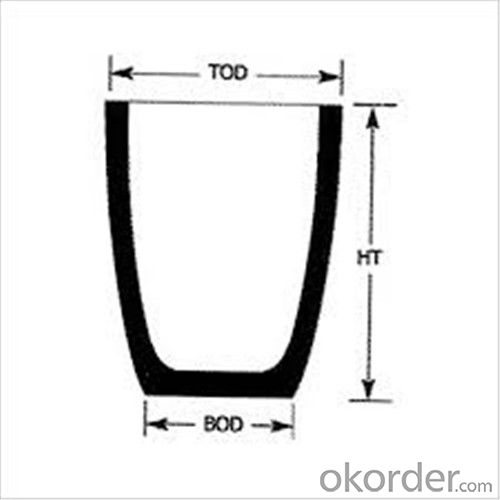

Refractory Crucibles Sic Crucible For Melting Copper/Brass/Aluminum
Physicochemical Properties
Type of Crucible | Type S | Type D |
Carbon Content/% | ≥38 | ≥45 |
Bulk Density/(g/cm3) | ≥1.70 | ≥1.85 |
Apparent Porosity/% | ≤29 | ≤21 |
Compression Strength/MPa | ≥20 | ≥25 |
Refractoriness/°C | ≥1400 | ≥1400 |
Type S: Clay graphite crucible
Type D: Isostatic pressing graphite crucible
Cited from CNS China National Standard of Graphite Crucible, which is solely drifted by TIANFU company.
Content Composition
C% | Sic% | AL2O3% | SIO2% |
45%-50% | 20%-30% | 10%-12% | 15-25% |
Packaging & Shipping
Package: Wooden case and wooden pallet or pack as customer's requirement of graphite crucible.
Delivery time: depend on distance, usually 20 days to 50days after deposit of graphite crucible.
We can supply the products according to customer's drawings, samples and performance requirement.
Other Products

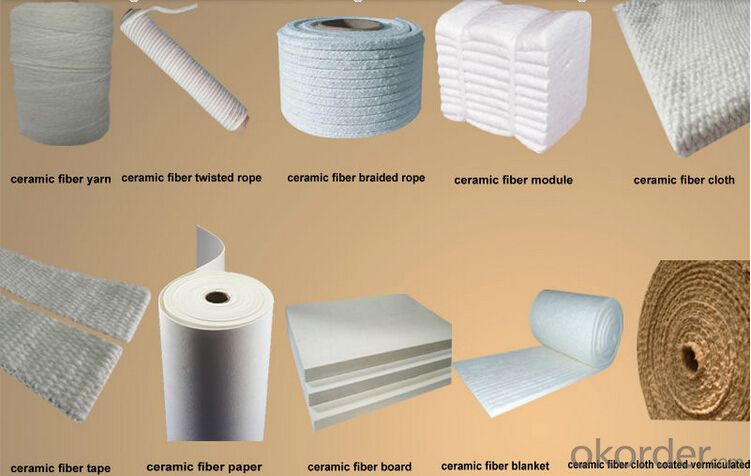
FAQ
1.What's your MOQ?
We will indicate the MOQ for each item in the quotation list. We accept the sample and trail order.
2.Can I negotiate the Prices?
Sure, we may consider discounts for bulk order of products.
3.How long will it take to complete my order?
For the stock items, we can arrange the shippment within 2~3days after received your payment. For the customized items, we will indicate the delivery time in the quotation list.
4.Can you give warranty of your products?
Yes, we extend a 100% satifisfaction guarantee on all items. Please feel free to provide timely feedback if you're not satisfied with N&D's Quality and Service. For the overseas orders, if there is a quality problem, please kindly to provide the picturers to show the problem by e-mail. We will provide the replacements to you at our cost according to actual conditions.
Welcome to visit our factory.
- Q:Does a graphite crucible react with any substances during use?
- No, a graphite crucible does not react with any substances during use. Graphite is chemically inert and has a high melting point, making it ideal for use in high-temperature applications such as melting metals. It does not react with the materials being melted or with any other substances present in the crucible. This property of graphite allows for the safe and efficient handling of various substances during processes such as metal casting, melting glass, or performing chemical reactions.
- Q:Does the graphite metal pad have any requirements on the sealing surface?
- The graphite composite gasket can be processed into the following forms according to the needs of use: 1. basic graphite composite gasket, 2. package inner graphite composite gasket, 3. outer graphite composite gasket 4., inner and outer edge graphite composite gasket. The graphite composite gasket has the advantages of keeping the excellent performance of the original gasket, easy installation and disassembly, uneasy damage, and preventing the medium from eroding the gasket and improving the pressure resistance. Commonly used wrapping material is 304 or 316 stainless steel.
- Q:How long is the service life of the cast iron crucible?
- Depends on the use of the user. The graphite crucible has the advantages of high cost and easy cracking; the service life of the cast iron crucible is lower, but the utility model has the advantages of energy saving and low cost compared with the graphite crucible, and each has its own advantages and disadvantages.
- Q:Is it possible to repair a cracked or damaged graphite crucible?
- Repairing a cracked or damaged graphite crucible is indeed possible, but the success of the repair depends on the extent and location of the damage. Typically, specialized graphite repair compounds or pastes are used to fix these crucibles. These compounds are applied to the cracked or damaged area, and then heated to cure and bond with the existing graphite material. Once repaired, the crucible can be used again for various high-temperature applications. It is worth mentioning that the repair process might not always succeed, particularly if the damage is severe or if the crucible is compromised in a critical area. In such cases, replacing the crucible becomes necessary to guarantee the process's integrity and safety.
- Q:Is graphite crucible resistant to hydrofluoric acid?
- Mainly depends on the use of working conditions, the use of air, then more than 600 degrees Celsius will begin to be oxidized, and the service life will not be long.
- Q:Can graphite crucibles be used for semiconductor manufacturing?
- No, graphite crucibles cannot be used for semiconductor manufacturing.
- Q:Can graphite crucibles be used for melting thermoplastics?
- No, graphite crucibles cannot be used for melting thermoplastics. Graphite crucibles are typically used for high-temperature applications such as melting metals and alloys due to their high melting point and excellent thermal conductivity. Thermoplastics have much lower melting points and require crucibles made of materials such as stainless steel or ceramic to withstand the lower temperatures and prevent contamination.
- Q:Can graphite crucibles be used for catalyst preparation?
- Yes, graphite crucibles can be used for catalyst preparation. Graphite crucibles are often used in high temperature applications due to their excellent thermal conductivity and resistance to thermal shock. They can withstand temperatures up to 3000°C, making them suitable for various catalyst preparation processes that involve high temperatures. Graphite crucibles provide a stable and inert environment for catalyst synthesis and preparation. They do not react with most chemicals, making them compatible with a wide range of catalyst materials and precursors. This allows for effective catalyst synthesis without the risk of impurities or unwanted reactions. Furthermore, graphite crucibles are known for their durability and long lifespan, which makes them cost-effective for repeated use in catalyst preparation. They can be easily cleaned and reused, reducing the overall cost of the catalyst preparation process. It is worth noting that the choice of crucible material may depend on the specific catalyst preparation process and the chemicals involved. While graphite crucibles are generally suitable for many catalyst preparation applications, some highly reactive or corrosive chemicals may require the use of alternative crucible materials, such as ceramic or quartz crucibles. Therefore, it is important to consider the specific requirements of the catalyst preparation process before selecting a crucible material.
- Q:How does the wear resistance of graphite affect the performance of a crucible?
- The performance of a crucible is heavily dependent on the wear resistance of graphite. A crucible, which is used to hold and heat materials at high temperatures in industrial processes, often relies on graphite due to its unique properties, including high thermal conductivity, chemical inertness, and thermal stability. When it comes to a crucible, its ability to endure wear and erosion caused by intense heat and chemical reactions is a major factor. Graphite, known for its exceptional wear resistance, can withstand these harsh conditions, making it an ideal material for crucibles. By ensuring wear resistance, graphite helps maintain the structural integrity of the crucible, preventing degradation or breakdown during use. This is crucial in preventing contamination of the materials being processed or heated in the crucible. Contamination can negatively impact the final product's quality and purity, resulting in financial losses and compromised performance. Furthermore, graphite's wear resistance affects the lifespan of the crucible. A crucible with high wear resistance will last longer, reducing maintenance costs and improving efficiency in industrial processes. This allows for repeated use without frequent replacement, which can be both time-consuming and expensive. Moreover, graphite's wear resistance also influences the crucible's thermal stability. With its high melting point, graphite can withstand extreme temperatures without deforming or losing structural integrity. This ensures that the crucible maintains its shape, preventing cracks or warping under thermal stress. The ability to withstand high temperatures is vital for processes that involve prolonged heating or exposure to intense heat. In conclusion, the wear resistance of graphite significantly impacts the performance of a crucible. Its ability to endure wear and erosion helps maintain the crucible's structural integrity, prevents contamination, and extends its lifespan. Additionally, graphite's thermal stability allows the crucible to withstand high temperatures without deforming or breaking down. Overall, the wear resistance of graphite is a critical factor in determining the efficiency and reliability of a crucible in various industrial applications.
- Q:What are the different methods of preventing cracks in a graphite crucible?
- To prevent cracks in a graphite crucible, there are several effective methods that can be utilized: 1. Employing preheating: Prior to use, it is beneficial to preheat the graphite crucible. This can be achieved by gradually increasing the temperature to the desired operating level. This gradual heating allows for uniform expansion of the graphite, thus reducing the possibility of thermal shock and subsequent cracking. 2. Implementing gradual cooling: After use, it is crucial to cool the crucible in a gradual manner. Abrupt changes in temperature can result in thermal stress and ultimately lead to cracks. By allowing the crucible to cool slowly, the risk of such stress is minimized. 3. Avoiding sudden temperature fluctuations: It is imperative to utilize the graphite crucible in a controlled manner, avoiding rapid temperature changes. Swift heating or cooling can induce thermal shock and increase the likelihood of cracking. Thus, maintaining a consistent temperature during both the heating and cooling processes is of utmost importance. 4. Exercising proper handling techniques: The careful handling of the crucible is vital in the prevention of cracks. Any instances of dropping or forcefully impacting the crucible against hard surfaces should be avoided, as this can result in physical damage and weaken the graphite structure. 5. Applying protective coatings: An additional layer of insulation and prevention of direct contact between the molten material and the graphite can be achieved by employing a protective coating on the inner surface of the crucible. This coating serves to reduce chemical reactions and thermal stress, thereby diminishing the risk of cracks. 6. Engaging in regular maintenance and inspection: Consistently inspecting the crucible for any indications of wear, damage, or cracks is indispensable. Identifying potential issues at an early stage can prevent further harm and ensure the longevity of the crucible. Through the implementation of these methods, the risk of cracks in a graphite crucible can be minimized. This ensures the crucible's durability and effectiveness in various high-temperature applications.
1. Manufacturer Overview |
|
|---|---|
| Location | |
| Year Established | |
| Annual Output Value | |
| Main Markets | |
| Company Certifications | |
2. Manufacturer Certificates |
|
|---|---|
| a) Certification Name | |
| Range | |
| Reference | |
| Validity Period | |
3. Manufacturer Capability |
|
|---|---|
| a)Trade Capacity | |
| Nearest Port | |
| Export Percentage | |
| No.of Employees in Trade Department | |
| Language Spoken: | |
| b)Factory Information | |
| Factory Size: | |
| No. of Production Lines | |
| Contract Manufacturing | |
| Product Price Range | |
Send your message to us
Refractory Crucibles Sic Crucible For Brass/Aluminum
- Loading Port:
- Shanghai
- Payment Terms:
- TT OR LC
- Min Order Qty:
- 1 pc
- Supply Capability:
- 1000 pc/month
OKorder Service Pledge
OKorder Financial Service
Similar products
New products
Hot products
Related keywords
